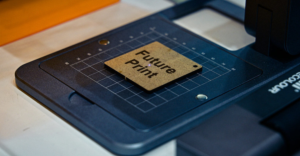Screen printing is a technique where ink is transferred through a stretched screen onto a surface to create images, texts, or patterns. Screen printing screens that are clean and in good condition are paramount to ensure quality and consistent results. Nascimento Rocha, technician, screen printing consultant, and teacher at Gênesis, states that clean screen printing screens prevent fungi and mold that can rot the ink. Besides, “screens in good condition (without warping or bends) prevent the patterns from becoming misaligned,” says the specialist.
How to properly clean screen printing screens before and after printing?
Nascimento explains that just as there are many types of ink, there also are many ways to clean and take care of your screens. Here are some tips:
- Before printing, clean all screens with a wet, lint-free cloth to remove dust. That prevents the ink from getting contaminated and dirty.
- After use, clean the screens as per the ink used:
- Solvent-based inks: use the solvent for the same ink and a rag to clean them;
- Water-based ink: use running water, a sponge, and detergent to clean all ink residues inside the screen. That will prevent the ink from peeling off inside the screen.
- Plastisol: use a suitable cleaning agent (screen cleaner) and a rag or some fabric to clean all the areas from inside the screen.
- For other paints, follow the same procedure.
A guide on how to store screen-printing screens and maximize their lifespan
Drying: Make sure the screens are completely dry before storing them. Moisture can lead to mold and damage the emulsion.
Protect them against dust and dirt: Place the screens in polyethylene or screen bags designed to protect against dust, dirt, and contaminants to prevent foreign particles from entering the mesh apertures.
Flat surfaces: Make sure the surface where screens are stored is flat and level to extend the lifespan of your screen.
Avoid direct sunlight: Store the screens in a fresh, dry, dark place, away from sunlight, as prolonged exposure can impair the emulsion.
Control moisture: Avoid storing the screens in humid areas or areas subject to extreme temperature changes, as the humidity can damage the emulsion and the screen frame.
Do not pile objects on the top of the screens: Avoid putting heavy objects or other materials on the top, as this can bend or damage the screen.
Labeling: Label each screen with relevant information, such as the design or image, the manufacturing date, and other relevant information. That will facilitate identification when you need to reclaim the screens.
Regular check: Check the screens regularly to ensure they are in good condition. Check also the emulsion, the screen, and cleaning.
Nascimento says: “I would not recommend that wooden screens, after washing, be left in the sun, as it may cause the frame to warp. Let them dry in the shade or in an oven at low temperatures (35ºC.) On the other hand, aluminum screens do not warp and can be left in the sun. To store them, line them up side by side,” he explains.
How to carry out preventive maintenance on screen-printing screens to avoid damage or excess wear and tear
Preventive maintenance not only extends the lifespan of your screens but also improves the quality of prints and the efficiency of the screen printing process. Take your time to take care of your screens and make sure they are always ready to deliver outstanding results.
As Nascimento explains, to extend the lifespan of your wooden screens, you can paint the frames with lacquer or varnish to prevent the wood from saturating and decaying. He adds: ” Before installing the screws, use grease to avoid them from rusting quicker. Aluminum screens do not require much care, as they do not rust or decay. A handful tip is that you should not use chlorine or derivatives to reclaim the screens, as it will reduce their lifespan”.
How to identify and solve common problems in screen-printing screens
- When the print is uneven or blurry
The lines and details in the print are not sharp; the edges of the images seem blurry, and the printing is not aligned with the substrate.
Tips:
- Check if the screen is tensioned.
- Adjust the pressure of your machine to ensure uniform contact between the screen and the substrate.
- Make sure the screen is aligned with the substrate before printing.
- Check if the substrate is positioned in the printing table.
- When there are stains or faults in the print
Print areas show some lack of ink. There can be areas with weaker or absent pigmentation.
Tips:
- Make sure the emulsion is evenly applied on the screen.
- Adjust the pressure of the printing machine to ensure proper ink transfer.
- When the ink is clogged or blocked
The ink does not pass through the screen openings evenly. The print may have missing parts where the ink did not pass through the mesh.
Tips:
- Check if the mesh openings are not obstructed by residues of dried ink.
- Use inks with proper viscosity and mix them properly.
- Check if the pressure is not too high, which can lead to clogging.
- When there are scratches in the emulsion.
Undesired lines or scratches appear on the prints, and the emulsion seems damaged in some areas.
Tips:
- Handle the screens carefully to avoid damaging the emulsion.
- Check for sharp or rough objects near the screens.
- Make sure the substrate is not damaging the emulsion while printing.
- When the emulsion does not adhere properly
The emulsion does not adhere to the screen evenly, resulting in uncoated areas.
Solution:
- Check if the screen is clean and has no residues before you apply the emulsion.
- Check how old the emulsion is, as older emulsions can be harder to adhere to.
- Follow the manufacturer’s instructions to apply the emulsion properly.
How to tell when it is the time to replace a screen and what to do with old ones
Nascimento explains that aluminum screens need to have their polyester mesh replaced when it tears apart since said screens do not lose tension. On the other hand, wooden screens can lose tension quickly if improperly stretched with clamps (distance clamps.) “When they start to warp, the polyester mesh loses pressure, and the outlook does not look the same. In other words, the screens become loose and may blur the print,” he concludes.
Did you like it? Now you know how to take care of your screen-printing screens. See also the ideal type of ink for screen printing – click here!





